Menu

Do you ever think about being truly safe when using pesticides? The EPA reports over 10,000 poisonings a year, with a quarter at work. Knowing how to handle pesticides safely is key for your health and nature.
Reading and following pesticide labels is very important. They guard against risks and make sure you’re using them legally. Keep kids and pets away from where you’re spraying. They are extra sensitive to pesticides.
Using the right clothes while spraying is also vital. Dress in long sleeves, trousers, and closed shoes to protect yourself. Sometimes, the label might say to use more gear. Have something to soak up spills nearby. Try not to waste water when you clean up to stop spreading toxins.
It’s smart to know who to call in an emergency. The Poison Control Center can help at 1-800-222-1222 for big problems. For regular issues, like safety tips, call NPIC on 800-858-7378 from 8:00 AM to 12:00 PM Pacific Time, Monday to Friday. Remove your stuff from where you’re treating to avoid it getting contaminated.
Make sure you use pesticides where the air moves well indoors. Outside, pick days without much wind to keep pesticides in one place. Always wash your hands well after using pesticides to not eat or spread them.
It’s key to understand what’s on pesticide labels for safe and effective use. These labels give clear instructions that are vital to follow. Doing so keeps us safe, meets the law, and lessens dangers from the pesticides.
Pesticide labels are packed with important info such as what’s in it, how toxic it is, and how to safely use it. Each label has signal words like “Caution,” “Warning,” or “Danger” to show how harmful it can be. We should always follow these warnings to stay safe.
Using too much pesticide can waste money, be bad for health, harm the environment, and not work well against pests. It’s a must to follow what the label says. Plus, picking the right one from many similar can avoid misuse.
Also, keeping pesticides away from children and pets is crucial. The details on labels help us know the risks and how to handle the product safely. EPA and University resources can give more help. They offer advice on reading labels and using pesticides without risks.
Selecting the right pesticide is key for effectiveness and safety. It starts with knowing the pest and its characteristics. Then, we look at how the pesticide might affect the environment.
The first step is to know which pest you’re dealing with. Not all pesticides kill every pest. For example, some kill insects but not diseases on trees. Also, some pesticides only work on certain plants like dandelions. By knowing your pest, you can pick the best pesticide.
After knowing the pest, we check the pesticides’ chemical traits. Some work best at specific times. It’s crucial to understand how they work to avoid negative effects. Look out for words like “Caution” on labels. This tells you how safe the pesticide is for people and nature.
How pesticides affect the environment is very important. We must think about the impacts on other plants and animals. Using a pesticide that fits the area helps with safe pest control. Always follow the label’s advice on safe use.
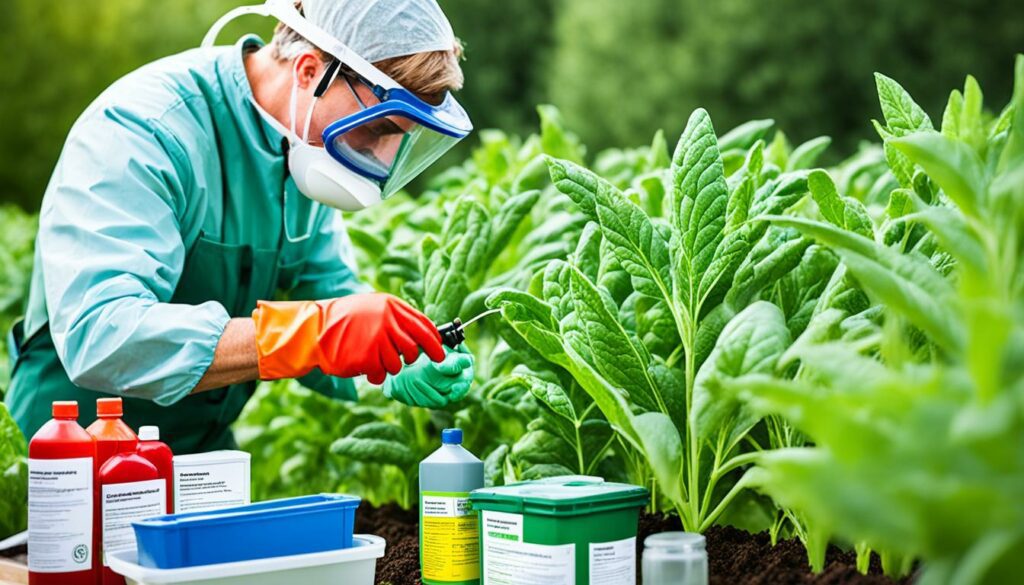
Home pesticides can be in many forms, like sprays or baits. Each one is for different pests or places. Knowing these details helps pick the best pesticide. This way, we control pests while keeping people and the environment safe.
Keeping safe while dealing with pesticides relies on using Personal Protective Equipment (PPE) well. It’s crucial to protect against pesticide exposure. This can happen through skin, breathing, eating, or getting in your eyes. The labels tell us how to stay safe, offering important advice.
When we spray pesticides, about 97 percent of the danger is from touching them. So, choosing the right protective clothing for pesticides is vital. The labels usually say to use gloves that are either waterproof or chemical-resistant. These gloves should range from 12 to 22 mils thick. They’re often made of barrier laminate, butyl rubber, nitrile rubber, neoprene, natural rubber, polyethylene plastics, polyvinyl chloride, or Viton. And for shoes, chemical-resistant boots with a coating of polyurethane or polyvinyl chloride are best.
It’s advised to wear chemical-resistant coveralls. They’re typically made from butyl rubber, neoprene, PVC, or coated polyethylene. Pair them with boots that pull on one piece or use shoe covers. Remember, if your cotton glove liners get wet, throw them away.
Looking after your eyes and lungs is crucial when you’re working with pesticides. For your eyes, use goggles, face shields, or safety glasses that meet ANSI Z87.1 standards. Safety glasses work if the pesticides are less toxic. Go for goggles with cups or covers for stronger protection.
If there’s a chance pesticides might splash, wear a face shield with your glasses or goggles. And in some cases, you’ll need to protect your head from things falling from above.
For your breathing, pick a respirator that matches the pesticide’s danger levels. The pesticide label will tell you what you need. The right choice keeps you safe from what you might breathe in.
| Protective Item | Material | Specifications |
|---|---|---|
| Gloves | Barrier laminate, butyl rubber, nitrile rubber, neoprene rubber, natural rubber, polyethylene plastics, polyvinyl chloride, Viton | 12-22 mils thickness |
| Boots | Natural rubber, polyurethane, polyvinyl chloride | One-piece, pull-on |
| Coveralls | Butyl rubber, neoprene, PVC, coated polyethylene | Chemical-resistant |
| Eye Protection | Goggles, face shields, safety glasses | ANSI Z87.1 impact-resistance |
| Respiratory Protection | Respirators | Based on specific chemical hazards |
Using PPE the right way, as the labels say, is key to being safe with pesticides. This helps lower the risk of being exposed to harmful pesticides.
Ensuring pesticide safety requires thorough pesticide application preparation. I focus on creating a plan for emergencies like spills or exposure. Following guidelines closely is vital; 80% of accidents happen because of wrong use.
Having clean water nearby is crucial for washing off pesticides fast. It’s noted that 75% of spills cause harm as they’re not contained well. Being ready and watching out can cut exposure risks by a lot.
Only 10% of people use proper ventilation inside when applying pesticides. Also, 40% of indoor uses aren’t aired out enough. So, it’s smart to have fresh air present and to pick calm days for outdoor work to limit spread.
Removing your stuff from where you’re working cuts down the chance of getting pesticides on them. Half the users don’t do this. Also, carefully read and stick to the labels when mixing. They tell you how to do it safely.
Wearing the right gear greatly lowers your risk. Use chemical-resistant goggles, long rubber gloves, a long shirt, and respirators.
Shockingly, only 40% of users check the label’s first aid tip. Make sure you know these steps and have them ready. And, just 10% work in well-ventilated spaces when mixing. This shows we need to be more careful.
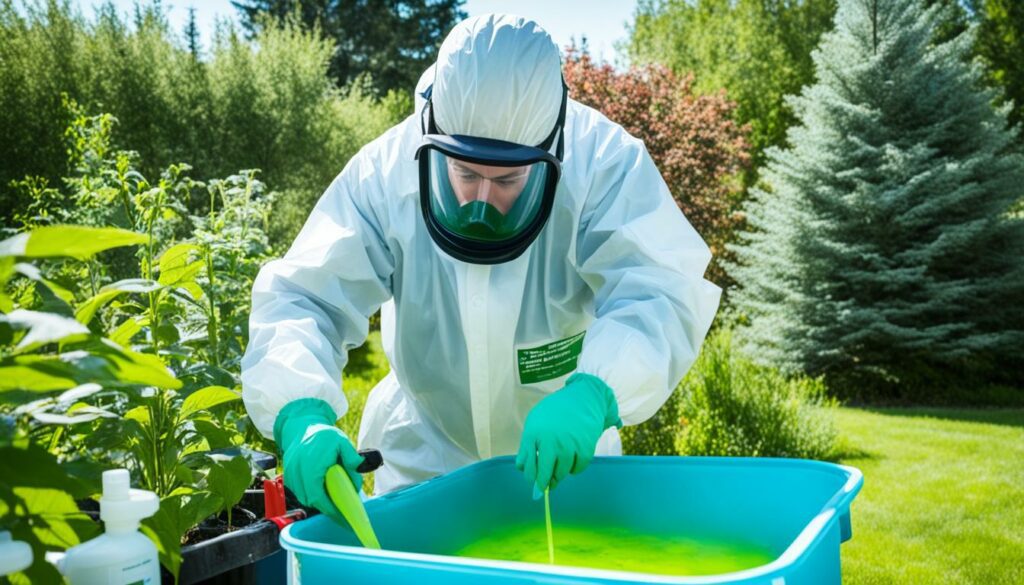
Be careful about the wind and your surroundings when working with pesticides. Standing upwind can reduce your exposure to toxic gases and mists. Also, always check the label for when it’s safe to re-enter treated areas.
Storing pesticides properly after you use them is very important. Keep them in a separate, safe place, check for leaks, and use the original packaging. This keeps everyone safe even after you’re done spraying.
Ensuring pesticide safety requires thorough pesticide application preparation. I focus on creating a plan for emergencies like spills or exposure. Following guidelines closely is vital; 80% of accidents happen because of wrong use.
Also, having clean water nearby is crucial for washing off pesticides fast. It’s noted that 75% of spills cause harm as they’re not contained well. Being ready and watching out can cut exposure risks by a lot.
Only 10% of people use proper ventilation inside when applying pesticides. Also, 40% of indoor uses aren’t aired out enough. So, it’s smart to have fresh air present and to pick calm days for outdoor work to limit spread.
Removing your stuff from where you’re working cuts down the chance of getting pesticides on them. Half the users don’t do this. Also, carefully read and stick to the labels when mixing. They tell you how to do it safely.
Wearing the right gear greatly lowers your risk. Use chemical-resistant goggles, long rubber gloves, a long shirt, and respirators.
Shockingly, only 40% of users check the label’s first aid tip. Make sure you know these steps and have them ready. And, just 10% work in well-ventilated spaces when mixing. This shows we need to be more careful.

Be careful about the wind and your surroundings when working with pesticides. Standing upwind can reduce your exposure to toxic gases and mists. Also, always check the label for when it’s safe to re-enter treated areas.
Storing pesticides properly after you use them is very important. Keep them in a separate, safe place, check for leaks, and use the original packaging. This keeps everyone safe even after you’re done spraying.
Mixing pesticides safely is vital for our health and the planet. It requires following safety steps to avoid harm when working with pesticides. Wearing the right clothes and using the right gear is a big part of these steps.
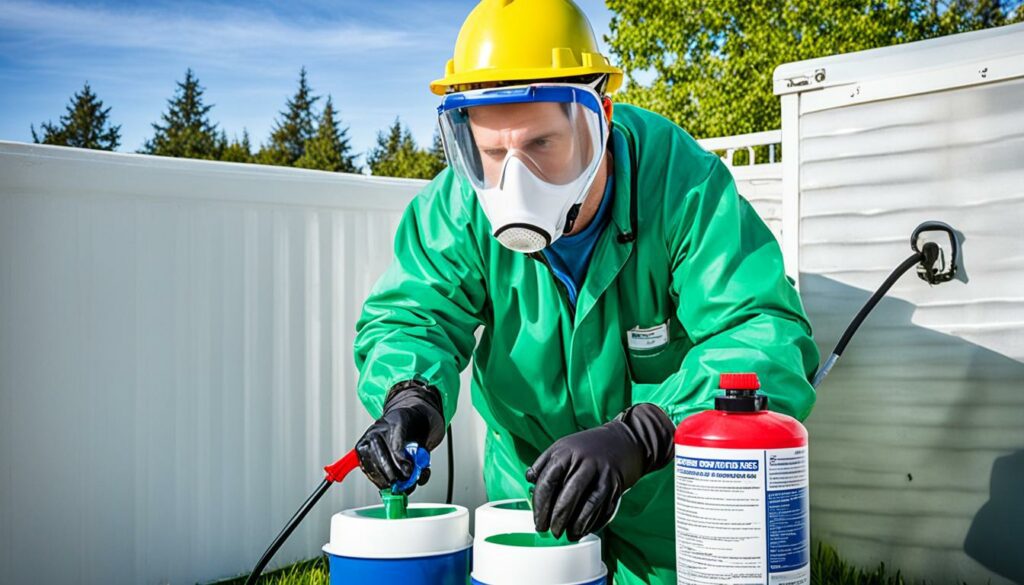
To stop pesticide spills, pick the right place to mix them. Do it outdoors or in a place with lots of fresh air. This lowers the chance of harm from the chemicals. If a spill happens, you should have paper towels, sawdust, and gloves that don’t absorb ready. Quick clean-ups help keep us and the environment safe.
Also, mix pesticides where they can’t splash up. And always wear the right gear, like long-sleeved shirts, long pants, and closed shoes.
When working with strong pesticides, safety is key. Use gloves that don’t absorb and wear overalls, rubber boots, and a mask. Only mix as much pesticide as you need at that moment. This avoids extra chemicals to store or throw away.
Mix pesticides low to the ground and away from your face. This lowers the risk of touching or breathing in the chemicals. Always wash your hands well after working with pesticides. This stops you from getting sick if you eat or smoke later.
If there’s an accident or you feel sick from the pesticides, get help right away. Call the Poison Control Center at 1-800-222-1222. Or contact the National Pesticide Information Center (NPIC) at 1-800-858-7378. They’re open from 8:00 AM to 12:00 PM Pacific Time, Monday to Friday.
Using the right pesticide application techniques is vital for safety and protecting the environment. I recommend mixing and spraying ground-level. This can cut down the danger of getting too much pesticide on your skin or breathing it in. It’s a smart move to keep you and others safe.
One key tip is to mix pesticides at ground level. Doing this means there’s less chance of getting them on you. It’s what pesticide labels usually tell you to do. And don’t forget to wear the right equipment like chemical-proof goggles, long rubber gloves, and a tough, long-sleeve shirt. These steps really lower your risk when dealing with pesticides.
Spraying upwind is another great idea. It means making sure the wind blows the chemicals away from you. This way, you won’t breathe in anything harmful. It also makes sure the pesticide lands where you want it, not where it shouldn’t. Using this method helps keep you safe and makes the pesticide work better.
By following these pesticide application techniques like mixing at ground level and spraying upwind, you improve everyone’s safety. These steps are key to reducing the chances of the pesticide getting on your skin, in your eyes, mouth, or lungs. Always check the labels and follow local rules, which might need special training for working with pesticides.
| Technique | Benefit | Precaution |
|---|---|---|
| Ground-Level Mixing | Reduces splash hazards | Wear appropriate PPE |
| Spraying Upwind | Minimises inhalation risk | Avoid windy conditions |
Over a billion pounds of pesticides are used in the United States each year. This highlights the need to really understand the dangers they pose. Most of these chemicals deal with a wide range of pests but also harm important species like pollinators.
Insecticides like neonicotinoids, organophosphates, and pyrethroids vary in how harmful they are. Some, like neonicotinoids, can stick around for a long time in the environment, making the risks even greater. To judge how dangerous a pesticide is, look at the signal words on its label such as CAUTION, WARNING, and DANGER.

To know about pesticide risks, we need to understand both how toxic they are and how we’re exposed. The risk from a pesticide depends on how toxic it is and how we come into contact with it. Even organic pesticides can be dangerous to pollinators, showing no pesticide is completely risk-free.
Many different chemicals can be found in pesticides, making them more challenging to evaluate. You can get help in understanding these risks from groups like the National Pesticide Information Center and the EPA. It’s especially important to think about how pesticides might affect children and pregnant people more severely.
Choosing less toxic options and reducing how much we’re exposed to are key steps. Understanding the dangers of pesticides and how we may be exposed helps us use them more safely. Being well-informed when using pesticides helps protect us and the environment from their harm.
| Class | Examples | Risks |
|---|---|---|
| Insecticides | Neonicotinoids, Organophosphates | Persist in environment; impact non-target species |
| Herbicides | Glyphosate | Disrupts pollinator behaviour; linked to decline in monarch butterflies |
| Fungicides | Various formulations | Can enhance toxic effects of insecticides; harm to pollinators |
Fast action is key when dealing with pesticide exposure. Knowing how to react can keep you safe and get medical help fast.
Quick first aid is crucial right after exposure. If someone gets pesticides on them, move them away quickly. Aim to get 100 feet away to lower the risk of breathing in more pesticide. For skin contact, wash the area thoroughly with soap and water and take off any touched clothes. Remember, clothes that aren’t too dirty can be washed separately. Use hot water and a strong detergent.
If pesticides get in someone’s eye, rinse the eye straight away. Use clean water and rinse for 15 full minutes. This helps stop the pesticide from going deeper. If pesticides are swallowed, don’t make them vomit unless a doctor says to. If it’s a strong poison, drink plenty of water or milk. Then call the National Poison Center at 1-800-222-1222. Also, call 911 for urgent advice.
Getting in touch with poison control is very important. You can reach them by calling the National Poison Center. Make sure to give them exact details about the pesticide. This helps the doctors give the right treatment fast. Giving first aid while waiting for help can improve the person’s chances of getting better.
Employers should tell health workers all about the pesticide. This info lets them treat the victim correctly, right away. It’s very important to clean off the pesticide fast. Acting quickly usually means a better recovery. First aid is just the first step. Always seek professional help for a complete recovery and to avoid long-lasting harm.
Storing pesticides correctly is key for safety and how well they work. It’s vital to store them properly to keep them safe and their labels in good shape.
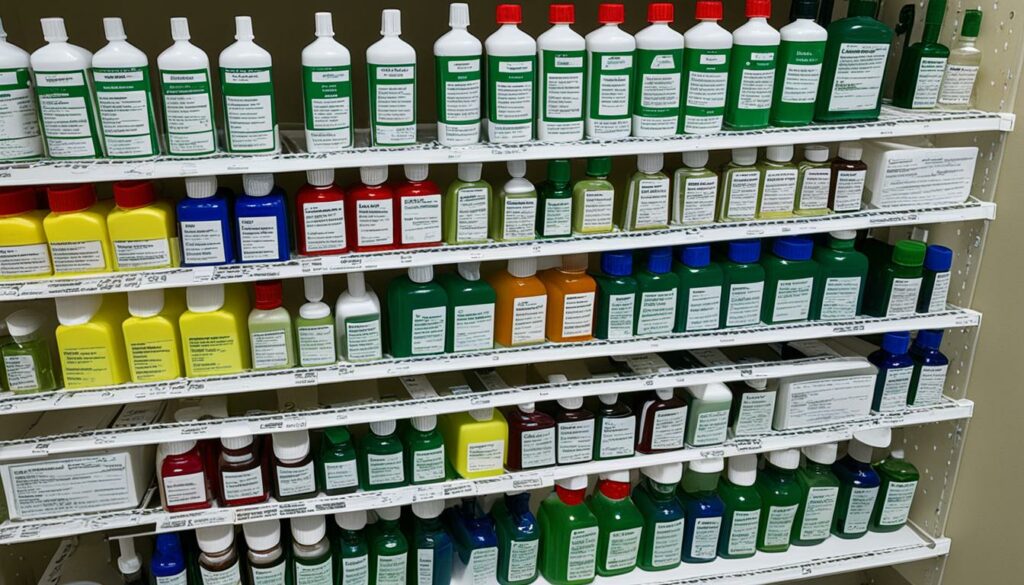
Keeping the labels clear on pesticide containers is very important. This helps avoid misuse and contact with the chemicals. Don’t store them in damp places to stop the labels from getting damaged. Also, keep them off the floor to avoid water harm.
Shelves that hold these should not be made of untreated wood or any material that can’t resist the chemicals. They should allow for keeping dry and liquid pesticides separately. These shelves need to be made of treated wood or metal.
| Storage Feature | Specifications |
|---|---|
| Metal Cabinets | Double-walled, 18-gauge sheet metal |
| Wooden Cabinets | 1″ thick exterior grade plywood |
| Shelves | Chemically resistant wood or metal |
| Cabinet Doors | High enough sill to contain 5 gallons of spilled liquid |
Put up pesticide warning signs to keep others away from the storage area. These signs warn about dangers and help prevent accidents. The storage area should be far from water sources to avoid pollution. It also stops people from stealing or misusing the pesticides.
Keep pesticides in a place where only those with the right training can go. This makes the storage safer and more secure. Use materials that don’t burn or soak up the chemicals. Make sure there’s enough room for all the containers, even the empty ones.
Keep the storage temperature right, between 40 and 90°F, and away from sunlight and extreme temperatures. This keeps the pesticides working well for longer.
Throwing away pesticides correctly is key to lessening their harm on the environment and people. It involves following the disposal instructions on the label and knowing how to do it safely. This ensures the environment isn’t harmed.
For getting rid of pesticides you don’t need, talk to your local waste facility. They will guide you to the right disposal places. For detailed advice, call 1-800-CLEANUP (1-800-253-2687). While there’s a general disposal method set by the government, each state might have stricter rules.
Always use the disposal advice found on the product’s label. It’s usually under “Storage and Disposal”. Make sure to wash empty containers well. But, never let the rinsing water go into drains or areas where it’s not safe. This stops pollution.
Know the pests you’re fighting before buying a pesticide. When you take them to be thrown away, keep them in the original packages. Make sure they won’t spill in your car. Keep pesticides away from food and cover them if you have an open truck.
To cut down on the pesticide waste’s bad effect, it’s vital to handle the waste correctly. Here’s how it’s divided:
Harmful waste – due to being flammable, corrosive, reactive, or toxic – needs pros to get rid of it. Places that make little waste have six months. But the big producers have just three.
Farmers must follow state rules when throwing away non-hazardous pesticides. They need to check that the disposal advice matches what the law says. This way, water stays clean.
For more help, look at advice from the US Environmental Protection Agency and universities like the University of Florida and Penn State.
| Pesticide Handling Guideline | Action |
|---|---|
| Contact Local Waste Management | Contact your local hazardous waste facility for advice |
| Rinsing Containers | Rinse thoroughly before disposal |
| Use of Protective Equipment | Wear chemical-resistant gloves and eye protection |
| Prevent Environmental Contamination | Avoid pouring rinse water into drains or on unspecified sites |
| Proper Transport | Transport pesticides in original containers with labels |
By sticking to the right disposal steps, you help keep the environment and people safe.
The effects of pesticides on our health are very wide. In the United States, farm workers faced 883 to 898 cases of poisoning from 1998 to 2005. Symptoms like headaches and blurry vision might not seem serious at first. However, they can get very bad if not treated.
A study found that 6442 to 6471 workers had breathing problems from pesticide exposure. This shows just how dangerous it can be to breathe in these chemicals.
Long-term exposure to pesticides can lead to serious health issues. These include cancer, nervous system problems, and birth defects. The harm from long exposure can be very severe.
Studies on farm workers have shown how widespread these risks are. In one study, 285 to 288 farm workers reported health issues from pesticide exposure. This highlights the common threat.
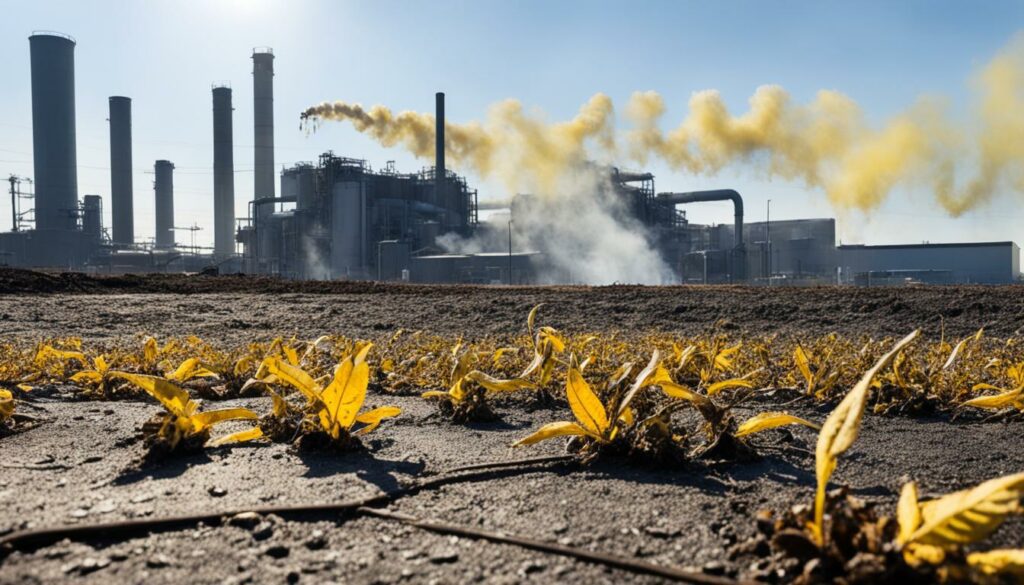
In France, vineyard workers faced health issues due to regular pesticide contact. Also, a study on farm workers that move around found 538 to 553 possible cases. This means we need to do more to protect these workers.
Understanding the risks of pesticides is very important, especially for those who use them. Wearing the right protective gear, following safe practices, and knowing the risks are key. This will help in making safer choices about using pesticides.
Making sure workplace pesticide safety is top-notch is very important. This is because using pesticides comes with big risks. If someone is around pesticides a lot, they might have health problems later on.
Groups like OSHA and EPA set rules for working with pesticides. These rules are very important. Everyone who works with pesticides must be over 18 and trained every year. This is by laws found in places like California.
Following pesticide regulations is a must. Pesticides come with labels that show how dangerous they are, like DANGER or CAUTION. It’s the boss’s job to make sure workers read and follow these labels. Even stuff like cleaning products are in this category!
Personal Protective Equipment (PPE) is very important. This includes suits and gloves that keep chemicals away from your skin. Always wear the right PPE, as the label or the law suggests. To keep your PPE working well, wash it often.
There should be eyewash stations near where pesticides are used. This is to help if something gets in your eyes. If you’re worried about safety, reach out to NPIC, local officials, or OSHA.
Think about using Integrated Pest Management (IPM). It can be both cheaper and safer than the old ways. It’s good for protecting against pesticides because it uses fewer harmful chemicals.
People need to learn about the danger of pesticides and how to stay safe. Training should teach what pesticides can do to your health and how to handle accidents. Knowing these things makes everyone safer at work.
Sticking to pesticide safety regulations is key to using pesticides correctly. It means getting the right certifications and following strict laws on their use.
Following pesticide legal requirements means knowing and obeying the laws on how to use pesticides. This includes getting your license renewed on time – like during the Renewal Season 2023 – and keeping up with new rules. Also, those with a license need to meet special requirements in each county. This includes paying any necessary fees to keep their license valid.
Being certified is crucial for those who use pesticides. To be certified, someone might need an Agricultural Pest Control Adviser License or a Qualified Applicator Certificate. They have to pass tough tests and take classes to keep learning. If someone wants to take a test, they need to apply by 4/15/2024.
For ongoing learning and to make sure they follow the rules, lots of approved and pending CE classes are there for license and certificate holders. It’s essential to keep up your education to follow the latest pesticide safety regulations.
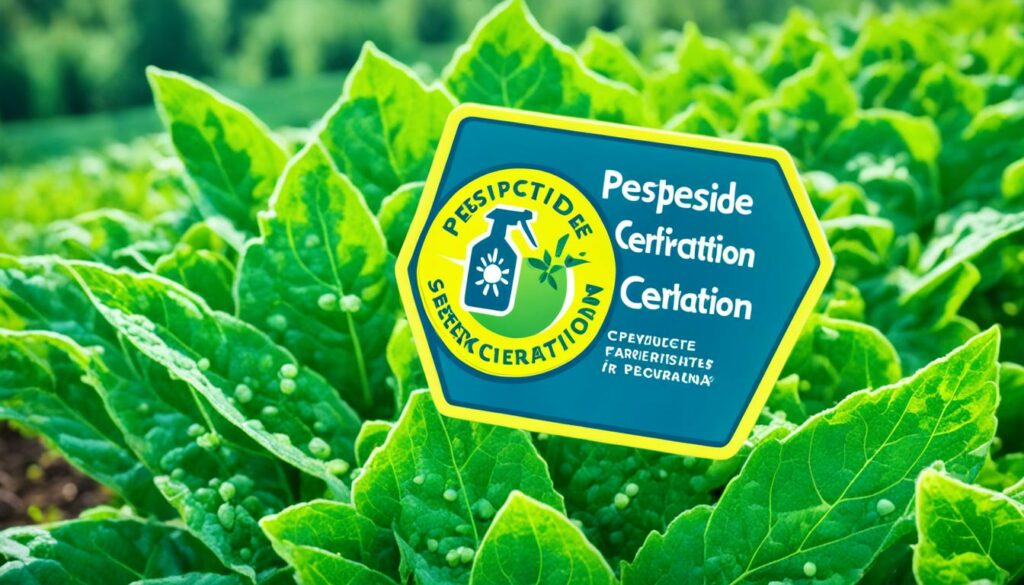
The table below shows different licenses and certificates for pesticide use. It also lists what more you might need and where to get help:
| License/Certificate Type | Description | Additional Requirements | Contact Information |
|---|---|---|---|
| Agricultural Pest Control Adviser License | Authorises the holder to provide pest control advice. | County Registration and Fees | Licensing and Certification Program, Continuing Education Program |
| Manned Pest Control Aircraft Pilot Certificate | Permits the operation of aircraft for pesticide application. | Exam and CE Classes | Pest Control Adviser Program |
| Pest Control Dealer Designated Agent License | Allows the holder to supervise pest control sales and applications. | Exam Schedule Info in PDF | Licensing and Certification Program |
| Qualified Applicator Certificate | Certifies competence in supervised pesticide application. | Exam Scheduling and Site Information | Continuing Education Program |
| Maintenance Gardener Pest Control Qualified Applicator License | Certifies ability to apply pesticides in maintained gardens. | Top 10 Violations of 2022 in PDF | Licensing and Certification Program |
Getting certified and sticking to the pesticide safety regulations are crucial. They help keep everyone safe and protect the environment from harm.
It’s vital to shield those at higher risk, like children and pregnant women, from pesticide dangers. Due to their stage of development, they are more sensitive to chemicals. This makes them especially vulnerable.
Children and pregnant women are at a higher risk from pesticides. This is because they go through many critical stages. These stages include when the baby is just starting to form, all through pregnancy, and in early life.
Studies have shown that pesticides can harm unborn babies if the mother is exposed. These studies are key to knowing the dangers and how to keep them safe.
Scientists also do tests with rodents. These tests look at the effects of pesticides on two generations. They focus on fetal growth, baby development, teenage years, and pre-adult stages. A big safety margin is used in making rules about pesticides. This includes extra protection for kids. This shows how serious the threat of pesticides to children is.
Keeping vulnerable groups safe is a major health concern. Tests check how pesticides affect wildlife and the environment. This is important for overall health. Studies show that Black and Mexican American communities are more exposed to pesticides than others.
Workers in fields, mainly Latinx people, also face high risks. Each year, up to 20,000 of them get sick from pesticides. Safety must improve, and rules should be followed better. It’s worrying that very few farms are checked to see if they protect their workers.
Problems like poverty linked with increased pesticide use are still not fully addressed. To protect everyone, strong public health rules are needed. This is the key to making sure all at-risk groups are safe.
Maintaining pesticide safety equipment is vital for personal safety. It’s key to clean and decontaminate PPE well. This keeps the risks of pesticide exposure low.
When you have clothes with pesticide on them, wash them alone. Use hot water and a strong detergent. This helps remove pesticide well. Plus, air drying stops pesticide from spreading further.
After cleaning, store PPE correctly for next use. Follow the maker’s storage tips. Dispose of PPE used with pesticides correctly to avoid residue spreading.
Decontamination is more than just cleaning. It’s also maintaining PPE’s ability to protect. Regularly check respirators and replace parts when needed.
Not following these practices may make your PPE useless. This increases the risk of getting sick. So, decontamination and good storage are very important.
The following table outlines the lifespan and effectiveness of different types of PPE, providing essential insights for users:
| PPE Type | Lifespan | Effectiveness |
|---|---|---|
| Reusable PPE | 5-7 Days | High, if properly cleaned and stored |
| Extra-Heavy-Duty PPE | 10-14 Days | Very High, suitable for extended use with proper maintenance |
| Non-Porous Gloves | Varies | Reduces pesticide exposure by up to 98% |
| Respirators | Depends on the manufacturer | High, requires annual fit tests and strict adherence to maintenance guidelines |
These practices for cleaning and storing safety equipment are crucial. They help reduce the danger of pesticide exposure. Following these steps is important for healthy living.
After looking closely at how pesticides are used safely, it’s clear that we need to be very careful. We must make smart choices to protect ourselves and the planet. This means knowing what’s on pesticide labels, picking the right ones, wearing the proper gear, and applying them safely.
Even though most farmers know a lot about using pesticides safely, they don’t always put this knowledge into action. In fact, while their knowledge is high at 84.8 out of 100, their actual safety practices are much lower at 50.8 out of 100. This big difference shows we need to help them turn what they know into what they do. More than 60% of farmers have the right knowledge, but they don’t always use it right. This is a big problem in keeping everyone safe from pesticides.
We also found that how much someone knows about pesticides is linked to their education level. This shows that educating farmers more can help them use pesticides more safely.
To wrap up, using pesticides safely is something we can all help with. It’s about giving the right education, following rules, and using the best methods. Keeping chemicals safe is very important. By doing our best, we make life safer for those who work on farms and for everyone else too.
Always follow the instructions on pesticide labels. Keep children and pets away from treated areas. Wear protective gear. Make sure the area is well-ventilated.
After using pesticides, wash your hands thoroughly. This prevents accidental ingestion or spreading chemicals.
Pesticide labels offer vital information to reduce risks and meet legal rules. It’s crucial to read and understand them. This helps you choose the right pesticide and use it safely and legally.
First, identify the pest you’re targeting. Then, check the pesticides’ impacts on the environment. Make sure your choice doesn’t harm other organisms.
This careful selection supports safe and eco-friendly pesticide use.
When handling pesticides, wear goggles and long gloves. Use a respirator, rubber boots, and full clothing. Choose your PPE based on the pesticides you’re using. This will lower your health risks.
Before applying pesticides, plan for emergencies. Keep clean water for washing and clear the area of personal items. These steps enhance safety and quicken response to accidents.
To mix pesticides safely, handle concentrates with care and mix away from your face. Do this at ground level and maintain a safe distance.
Follow the product’s mixing instructions closely. This reduces your exposure to the chemicals.
Mix pesticides at ground level and spray against the wind. This way, you’ll avoid breathing in or touching the chemicals. It makes you and the environment safer.
Using pesticides can lead to direct poisoning and long-term health issues. Knowing the risks is key to using these products safely.
If exposed to pesticides, leave the area and contain the contamination. Then, seek help from poison control. Quick action can lessen the chemicals’ harm.
To store pesticides safely, keep their labels and containers intact. Store them in a separate, marked area. This prevents accidents and keeps everyone safe.
Disposing of pesticides correctly is crucial. Follow the label’s disposal instructions to protect the environment and public health. Responsible disposal avoids contamination.
Exposure to pesticides can cause immediate symptoms like headaches. Long-term exposure might lead to serious issues such as cancer.
Knowing these effects helps in taking protection measures when using pesticides.
OSHA and EPA rules set the standards for safely using, storing, and applying pesticides. They ensure safety for workers in the pesticide industry.
To use pesticides, it’s important to know and follow state laws. Certification ensures you’re trained to use these products safely and legally.
Be extra careful around children and pregnant women, who are more vulnerable to pesticides. Implement measures to protect public health and the environment.
Clean clothes and PPE that have been exposed to pesticides separately. Store the cleaned items in a safe place to prevent contamination. This helps keep your safety gear effective and free from pesticide residue.